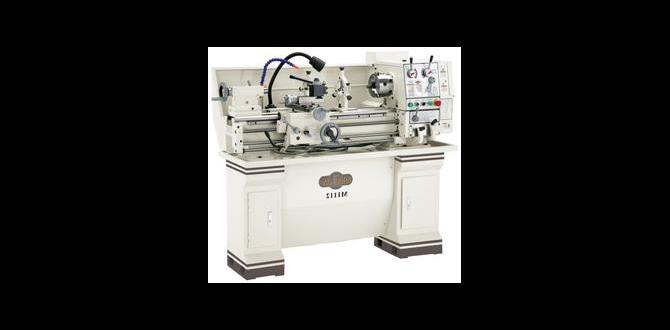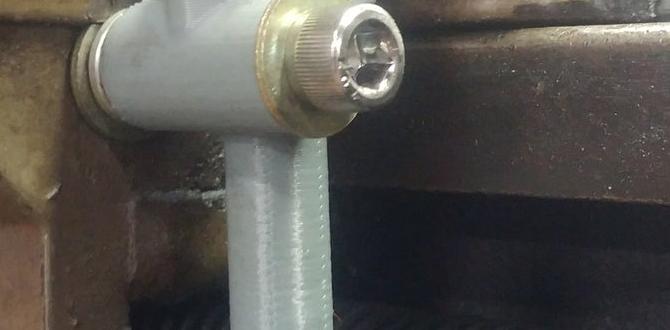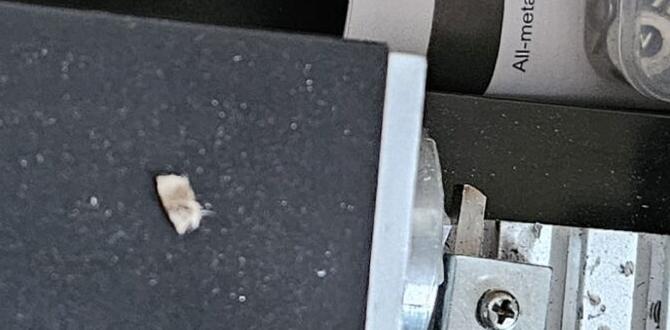Quick Summary:
A 3/16 inch carbide end mill is crucial for D2 chip evacuation. Choosing the right flute count and geometry, combined with proper speeds and feeds, ensures efficient chip removal, preventing tool breakage and improving surface finish in D2 steel. This guide explains how.
Hey there, fellow makers! Daniel Bates here from Lathe Hub. Ever found yourself battling a stubborn material like D2 tool steel, only to see your brand-new carbide end mill struggle? It’s a common frustration, especially when chips start packing up. This can lead to a ruined workpiece, a broken tool, and a whole lot of head-scratching. But don’t worry, we’re going to tackle this head-on. Understanding how to manage chips, or “chip evacuation,” is absolutely key when milling materials like D2, and the right 3/16 inch carbide end mill makes a world of difference. We’ll break down exactly what you need to know to get those chips flying out of the cut smoothly and safely. Let’s dive in and make milling D2 a whole lot easier!
Mastering D2 Tool Steel: Why Chip Evacuation is King
D2 tool steel. Just the name itself can conjure images of tough, resilient material that demands respect. It’s fantastic for tools that need to hold an edge and withstand hard use, but it’s also notoriously difficult to machine. One of the biggest challenges when working with D2, and many other hardened steels, is managing the chips produced during milling. If these chips don’t get out of the cutting area effectively, they can pile up, recut, and cause all sorts of problems.
This packing of chips is known technically as “chip welding” or “chip packing.” When chips build up, they essentially clog the flutes of your end mill. This means your tool isn’t actually cutting new material effectively; it’s pushing around hot, hardened chips. The results? Increased heat, excessive tool pressure, potential for tool breakage, work surface damage, and a generally miserable machining experience. For a beginner, this can be incredibly disheartening and costly. But understanding the role of your end mill, specifically how it helps evacuate those pesky chips, is the first giant leap towards success.
The good news is that with the right carbide end mill and a few smart strategies, you can achieve excellent chip evacuation even in tough materials like D2. Let’s get into the specifics of what makes a 3/16 inch carbide end mill perfect for this job and how to use it effectively.
The Secret Weapon: Your 3/16 Inch Carbide End Mill
When you’re facing a material like D2, the choice of cutting tool is paramount. For milling operations, the end mill is your go-to. And when we talk about small, intricate features or precise cuts in tough materials, a 3/16 inch carbide end mill, often with specific design features, becomes your best friend. Let’s explore why size and material matter, and what specific features to look for.
Carbide: The Material Advantage
Why carbide? High-Speed Steel (HSS) has been around for ages, but for materials like D2, carbide is generally the superior choice for end mills. Here’s why:
- Hardness: Carbide is significantly harder than HSS, especially at elevated temperatures. D2, being a hardened tool steel, requires a tool that can maintain its hardness under the heat generated during cutting.
- Rigidity: Carbide tools are stiffer, meaning they deflect less under load. This precision is vital for achieving accurate dimensions and a good surface finish, especially with smaller diameter tools like a 3/16 inch.
- Heat Resistance: D2 generates a lot of heat when machined. Carbide’s superior heat resistance allows it to maintain its cutting edge and structural integrity where HSS might soften and fail rapidly.
The 3/16 Inch Size: Precision and Reach
The 3/16 inch (which is approximately 4.76mm) diameter is a popular size for a reason, especially for hobbyists and those working on smaller projects or complex parts. Its smaller size allows for:
- Detail Work: Easily mill small radii, slots, and pockets that larger tools simply can’t access.
- Reduced Cutting Forces: For a given depth of cut, a smaller diameter tool generally requires less force to engage the material, which is beneficial for smaller milling machines or when working with thinner workpieces.
- Maneuverability: It’s easier to get this size tool into tighter corners and more complex geometries.
Key Features for D2 Chip Evacuation
Now, not all 3/16 inch carbide end mills are created equal, especially when it comes to handling tough stuff like D2. Here are the critical features to seek out:
1. Flute Count: More or Less?
This is one of the most important factors for chip evacuation. For milling hardened steels like D2, the flute count significantly impacts how well chips are cleared.
- 2 Flutes: Generally the best choice for milling D2 and other tough materials. Why? Fewer flutes mean larger chip gullets (the space between the cutting edges). These larger spaces are vital for holding and expelling the chips produced. They prevent the chips from getting wedged and recut, which is a major cause of tool failure.
- 3 or 4 Flutes: While often good for general-purpose milling in softer materials, 3 and 4 flute end mills have smaller chip gullets. This makes them more prone to chip packing in sticky materials like D2. They might be used in finishing passes if specialized geometries are employed, but for roughing and general milling of D2, stick with 2 flutes.
2. Helix Angle: The Steepness Factor
The helix angle is the angle of the flute spiraling around the tool. It affects how aggressively the cutting edge engages the material and how chips are directed upwards and out of the cut.
- High Helix Angle (e.g., 45-60 degrees): These tools have a steeper spiral. They tend to engage the material more gradually, leading to smoother cutting action and better chip evacuation, especially in gummy materials. The steeper angle helps “throw” the chip away from the cutting zone more effectively.
- Standard Helix Angle (e.g., 30 degrees): Common for general-purpose end mills, but can sometimes struggle with chip evacuation in very sticky materials.
For D2, a higher helix angle on your 3/16 inch carbide end mill is often preferred. It aids in both freeing the chip and reducing the cutting forces.
3. Neck Relief (Reduced Neck)
This is a game-changer for milling pockets and slots. A “neck relief” or “reduced neck” end mill has a portion of the tool shank ground away behind the cutting flutes. This means the cutting area is slightly smaller in diameter than the shank. For a 3/16 inch end mill, this feature is incredibly beneficial:
- Prevents Rubbing: Allows the non-cutting portion of the tool to pass through a pocket or slot without rubbing against the walls. This is essential when milling deeper slots or pockets where the full flute length is engaged.
- Enhanced Chip Flow: The reduced diameter can sometimes even help in directing chips out of the pocket more efficiently.
- Specific Tooling: Look for terms like “neck relief,” “reduced shank,” or “bottleneck” end mills. This feature is particularly important for tool steel milling where you might be taking axial depth of cut.
4. Corner Radius
Some 3/16 inch end mills come with a small corner radius (e.g., 0.010″ or 0.020″). This slightly rounded corner can help:
- Strength: Reduce stress concentration at the corner, making the tool less prone to chipping.
- Surface Finish: Can contribute to a smoother finish by controlling chip formation at the corners of a profile.
- For D2: A small radius is often beneficial as it adds a bit of robustness to the cutting edge, which helps in tough materials.
5. Coatings
While not always necessary for beginners, various coatings can significantly improve performance when milling D2.
- TiN (Titanium Nitride): A basic, general-purpose coating that adds some hardness and lubricity.
- TiAlN (Titanium Aluminum Nitride) or AlTiN (Aluminum Titanium Nitride): These coatings create a protective aluminum oxide layer at high temperatures, drastically improving performance and tool life in high-heat applications like machining tool steels. They are often the best choice for D2, though they can be more expensive.
Where to Find Such Tools
When you’re looking for a 3/16 inch carbide end mill with these features, don’t be afraid to browse specialized cutting tool suppliers. Brands like Sandvik Coromant, Iscar, Kennametal, and even high-quality offerings from companies like Milwaukee Tool or performance lines from hobbyist-focused brands often provide detailed specifications. Look for end mills designed for “hardened steels,” “alloy steels,” or “tool steels.”
A good example of what to search for might be a “3/16 inch 2 flute carbide end mill, 30 or 45-degree helix, neck relief, TiAlN coated.” You might also see tools specified for slotting or profiling which often incorporate these chip-clearing features. An 8mm shank is also common for this metric equivalent size, offering a good balance of rigidity and compatibility with many milling machine collets.
Setting Up for Success: Speeds, Feeds, and Coolant
Even the best end mill can fail if not used correctly. For D2, getting your speeds, feeds, and coolant strategy right is crucial for effective chip evacuation and tool longevity.
Speeds and Feeds: The Balancing Act
This is where things get a bit technical, but we’ll keep it simple. Speeds and feeds dictate how fast the tool spins (speed) and how fast it moves through the material (feed rate).
Surface Speed (SFM) and Spindle Speed (RPM)
Surface speed is the speed at which the cutting edge of the tool moves. For carbide tools in D2, you’re typically looking at surface speeds in the range of 200-400 SFM (Surface Feet per Minute). To calculate your spindle speed (RPM), you use the following formula:
RPM = (SFM × 12) / (π × Diameter)
For a 3/16 inch end mill (Diameter = 0.1875 inches):
RPM = (SFM × 12) / (3.14159 × 0.1875)
RPM ≈ (SFM × 20.37)
So, if you aim for 300 SFM:
RPM ≈ 300 × 20.37 ≈ 6111 RPM
Most small hobbyist machines might not reach these exact RPMs, so you’ll need to work within your machine’s capabilities. It’s often better to run slightly slower on RPM and adjust the feed rate than to run too fast and risk chatter or poor chip formation.
Feed Rate: Moving Through the Material
The feed rate determines how much material is removed with each tooth rotation (chip load). Chip load is the thickness of the chip being produced per cutting edge. For a 3/16 inch, 2-flute carbide end mill in D2, a typical chip load might range from 0.001″ to 0.003″ per tooth. Here’s how to calculate your feed rate (IPM – Inches Per Minute):
Feed Rate (IPM) = Chip Load × Number of Flutes × Spindle Speed (RPM)
Using our example of 6111 RPM and a chip load of 0.002″ per tooth:
Feed Rate = 0.002 × 2 × 6111 ≈ 24.4 IPM
Important Considerations for D2:
- Start Conservatively: Always start at the lower end of the recommended speeds and feeds. Listen to the cut, watch for chip formation, and observe the surface finish and tool’s temperature.
- Adjust for Rigidity: If your machine is very rigid and you have good coolant flow, you might be able to push these numbers a bit higher. If you experience chatter, poor chip evacuation, or excessive tool wear, reduce your feed rate and/or spindle speed.
- Depth of Cut (DOC) and Width of Cut (WOC): For D2, it’s usually best to take lighter axial depths of cut (how deep the tool goes down into the material) and moderate radial depths of cut (how wide the tool engages the material across its diameter). For chip evacuation, a radial width of cut of 20-50% of the tool diameter is often a good starting point. Full slotting (WOC = 100% of tool diameter) generates more heat and chips, so be extra careful there.
Resource: For a fantastic resource on calculating speeds and feeds, check out the resources at Machinability.com which offers detailed material data and calculators.
Coolant and Lubrication: Keeping things Happy
Coolant isn’t just about cooling; it’s also about lubrication and helping to evacuate chips. For D2, a good coolant strategy is vital.
- Flood Coolant: If your machine supports it, a high-pressure flood coolant system is ideal. It continuously flushes chips away from the cutting zone, preventing them from recutting and absorbing heat.
- Mist Coolant: A mist coolant system can also be very effective, especially for smaller machines. It sprays a fine mist of coolant and air directly at the cutting edge.
- Cutting Fluid/Lubricant: For very tough cuts or where flood/mist isn’t available, applying a specialized cutting fluid or high-pressure paste directly to the cutting area can make a big difference. Look for lubricants designed for harder metals.
- Air Blast: Even a simple air blast directed at the cut can help blow chips away, although it doesn’t offer the cooling or lubrication benefits of liquid coolants.
When in doubt, err on the side of more coolant or lubricant, especially when working with D2. The goal is to keep the tool and workpiece as cool as possible and ensure chips are being cleared effectively, not just stuck in the flutes.
A Step-by-Step Approach to Milling D2 with a 3/16″ Carbide End Mill
Let’s put it all together. Here’s a simplified workflow for milling D2 using your 3/16 inch carbide end mill, focusing on chip evacuation:
- Prepare Your Workpiece: Ensure your D2 steel is securely clamped in your milling vise or fixture. A stable setup is crucial for preventing vibration and ensuring predictable cutting.
- Select the Right End Mill: Choose a 3/16 inch, 2-flute carbide end mill. Prioritize one with a high helix angle and, if possible, a neck relief for pockets. A TiAlN or similar high-performance coating is highly recommended.
- Calculate Initial Speeds and Feeds: Use your material knowledge and machine capabilities to find a starting RPM and calculate your feed rate based on a conservative chip load (e.g., 0.001-0.002″ per tooth).
- Set Up Coolant: Ensure your coolant system is functional and directed at the cutting zone. If using manual application, have your cutting fluid ready.
- Program Your Toolpath:
- For pockets/slots: Use a helical interpolation or a trochoidal milling strategy if your CAM software supports it. These methods engage the tool gradually, taking small radial steps and larger axial depths, which is excellent for chip evacuation.
- For profiling/contouring: Use climb milling whenever possible. Climb milling pulls the workpiece into the cutter, which generally results in a better finish and chip flow compared to conventional milling.
- Depth of Cut: Start with a shallow axial depth of cut (e.g., 0.030″ – 0.060″ for a 3/16″ tool).
- Width of Cut: Aim for a radial width of cut between 20% and 50% of the tool diameter.
- Initiate the Cut: Start your CNC or manual mill. Listen carefully. The sound should ideally be a consistent “hissing” or “grinding” sound, not a harsh “banging” or “screeching.”
- Monitor Chip Formation: Watch the chips as they are produced. They should be relatively small, well-formed, and flung away from the cutting area. If you see large,






